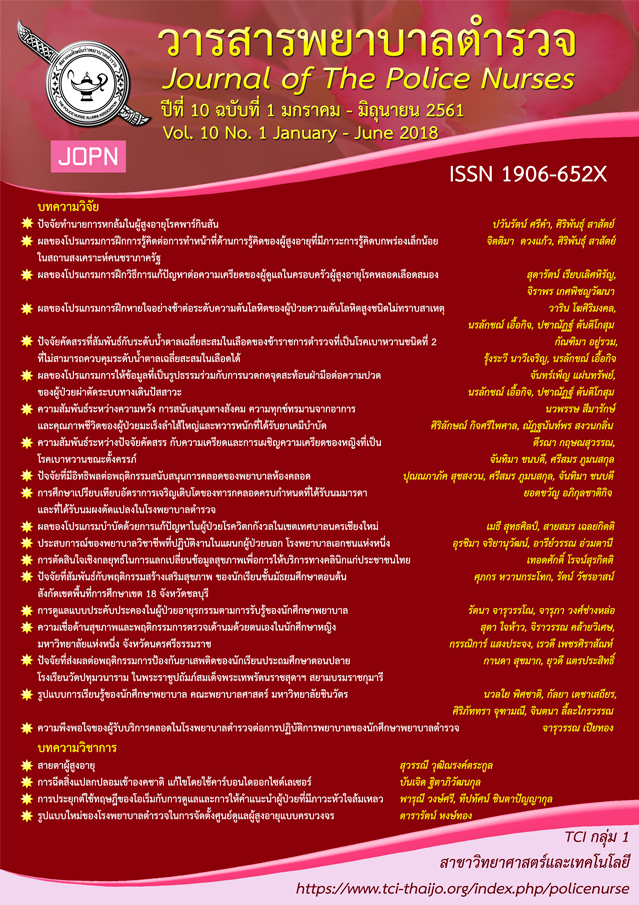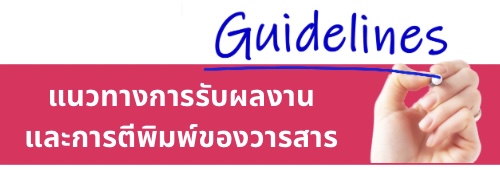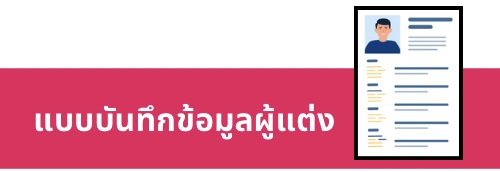ปัจจัยคัดสรรที่สัมพันธ์กับระดับน้ำตาลเฉลี่ยสะสมในเลือดของข้าราชการตำรวจที่เป็นโรคเบาหวานชนิดที่ 2 ที่ไม่สามารถควบคุมระดับน้ำตาลเฉลี่ยสะสมในเลือดได้
คำสำคัญ:
ระดับน้ำตาลเฉลี่ยสะสม, ข้าราชการตำรวจที่เป็นเบาหวานชนิดที่ 2บทคัดย่อ
การวิจัยนี้มีวัตถุประสงค์เพื่อศึกษาความสัมพันธ์ระหว่างระยะเวลาการเป็นโรคเบาหวาน ดัชนีมวลกาย ภาวะซึมเศร้า พฤติกรรมการรับประทานอาหาร พฤติกรรมการออกกำลังกาย พฤติกรรมการใช้ยา แรงสนับสนุนทางสังคม กับระดับน้ำตาลเฉลี่ยสะสมในเลือดของข้าราชการตำรวจที่เป็นโรคเบาหวานชนิดที่ 2 ที่ไม่สามารถควบคุมระดับน้ำตาลเฉลี่ยสะสมในเลือดได้ ตัวอย่าง คือ ข้าราชการตำรวจ อายุ 30-59 ปี ที่ได้รับการวินิจฉัยจากแพทย์ว่าเป็นโรคเบาหวานชนิดที่ 2 และได้รับการรักษาด้วยยาลดระดับน้ำตาลในเลือดแบบรับประทาน ที่เข้ารับการรักษาในแผนกผู้ป่วยนอก โรงพยาบาลตำรวจ และโรงพยาบาลดารารัศมี ซึ่งทำการเลือกตัวอย่างแบบเฉพาะเจาะจง จำนวน 130 คน เครื่องมือที่ใช้ในการวิจัย คือ แบบสอบถามข้อมูลส่วนบุคคล แบบสอบถามภาวะซึมเศร้า แบบสอบถามพฤติกรรมการรับประทานอาหาร แบบสอบถามพฤติกรรมการออกกำลังกาย แบบสอบถามพฤติกรรมการใช้ยา และแบบสอบถามแรงสนับสนุนทางสังคม เครื่องมือทุกชุดได้ผ่านการตรวจสอบความตรงตามเนื้อหาโดยผู้ทรงคุณวุฒิ 5 คน มีค่าความเที่ยงเท่ากับ .81, .76, .70, .80, และ .90 ตามลำดับ วิเคราะห์ข้อมูลโดยการหา ร้อยละ ค่าเฉลี่ย ส่วนเบี่ยงเบนมาตรฐาน ค่าสัมประสิทธิ์สหสัมพันธ์ของเพียร์สันและค่าไคสแควร์
ผลการวิจัยสรุปได้ดังนี้
- ระยะเวลาการเป็นโรคเบาหวานมีความสัมพันธ์ทางบวกกับระดับน้ำตาลเฉลี่ยสะสมในเลือดในระดับต่ำอย่างมีนัยสำคัญทางสถิติ (r=.22, p<.05)
- พฤติกรรมการรับประทานอาหาร และแรงสนับสนุนทางสังคม มีความสัมพันธ์ทางลบกับระดับน้ำตาลเฉลี่ยสะสมในเลือดในระดับต่ำอย่างมีนัยสำคัญทางสถิติ (r=.21 และ r=.26 ตามลำดับ, p<.05)
- ภาวะซึมเศร้าและพฤติกรรมการใช้ยามีความสัมพันธ์กับระดับน้ำตาลเฉลี่ยสะสมในเลือดอย่างมีนัยสำคัญทางสถิติ (χ2=5.82 และ χ2=4.32 ตามลำดับ, p <.05)
- ดัชนีมวลกายและพฤติกรรมการออกกำลังกายไม่มีความสัมพันธ์กับระดับน้ำตาลเฉลี่ยสะสมในเลือด (p>.05)
Downloads
ดาวน์โหลด
เผยแพร่แล้ว
รูปแบบการอ้างอิง
ฉบับ
ประเภทบทความ
สัญญาอนุญาต
ผลงานที่ได้ตีพิมพ์แล้วจะเป็นลิขสิทธิ์ของวารสารพยาบาลตำรวจ















